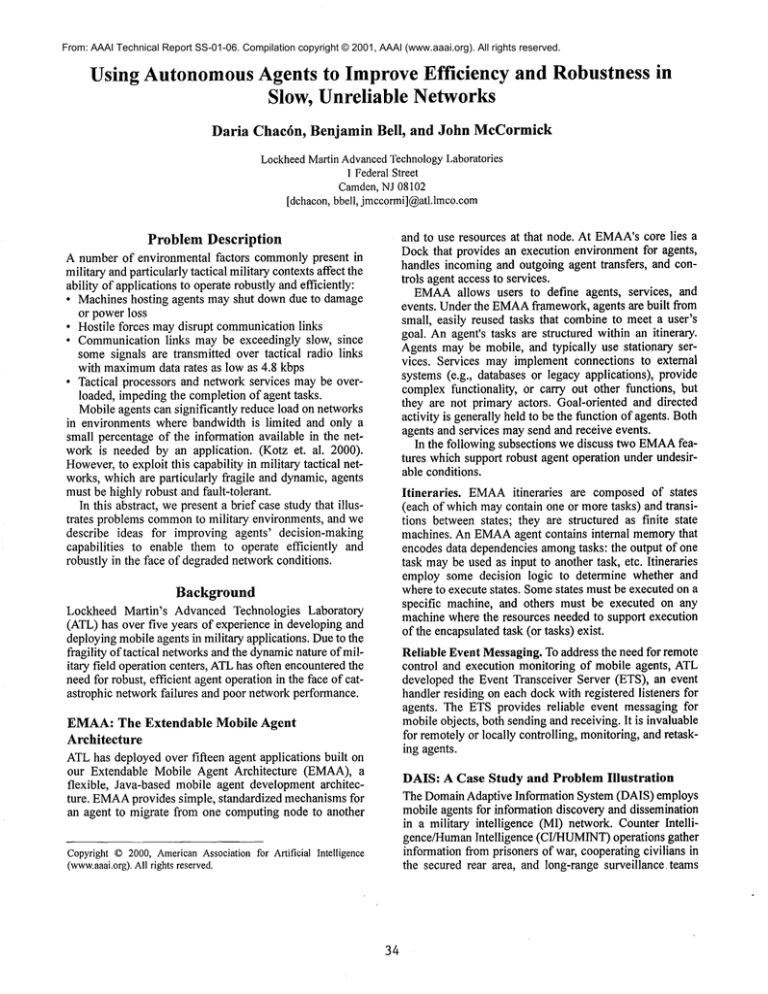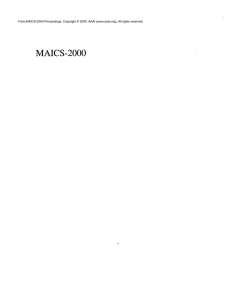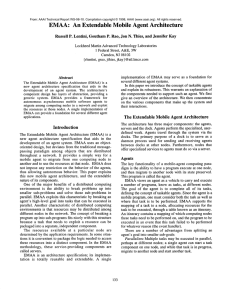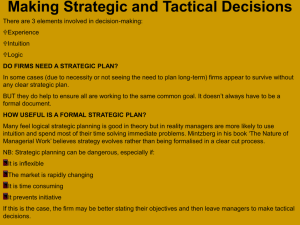
From: AAAI Technical Report SS-01-06. Compilation copyright © 2001, AAAI (www.aaai.org). All rights reserved.
Using AutonomousAgents to Improve Efficiency and Robustness in
Slow, Unreliable Networks
Daria
Chac6n,
Benjamin
Bell,
and John McCormick
LockheedMartin AdvancedTechnologyLaboratories
1 FederalStreet
Camden,NJ 08102
[dchacon,bbell, jmccormi]@atl.lmco.com
and to use resources at that node. At EMAA’s
core lies a
Dockthat provides an execution environment for agents,
handles incoming and outgoing agent transfers, and controis agent access to services.
EMAA
allows users to define agents, services, and
events. Under the EMAA
framework, agents are built from
small, easily reused tasks that combineto meet a user’s
goal. Anagent’s tasks are structured within an itinerary.
Agents maybe mobile, and typically use stationary services. Services may implement connections to external
systems (e.g., databases or legacy applications), provide
complexfunctionality, or carry out other functions, but
they are not primary actors. Goal-oriented and directed
activity is generally held to be the function of agents. Both
agents and services maysend and receive events.
In the following subsections we discuss two EMAA
features which support robust agent operation under undesirable conditions.
Problem Description
A number of environmental factors commonlypresent in
military and particularly tactical military contexts affect the
ability of applications to operate robustly and efficiently:
¯ Machines hosting agents may shut down due to damage
or powerloss
¯ Hostile forces maydisrupt communicationlinks
¯ Communicationlinks may be exceedingly slow, since
somesignals are transmitted over tactical radio links
with maximum
data rates as low as 4.8 kbps
¯ Tactical processors and network services maybe overloaded, impedingthe completion of agent tasks.
Mobileagents can significantly reduce load on networks
in environments where bandwidth is limited and only a
small percentage of the information available in the network is needed by an application. (Kotz et. al. 2000).
However,to exploit this capability in military tactical networks, which are particularly fragile and dynamic, agents
mustbe highly robust and fault-tolerant.
In this abstract, we present a brief case study that illustrates problems commonto military environments, and we
describe ideas for improving agents’ decision-making
capabilities to enable them to operate efficiently and
robustly in the face of degraded networkconditions.
Itineraries. EMAA
itineraries are composedof states
(each of whichmaycontain one or more tasks) and transitions betweenstates; they are structured as finite state
machines. An EMAA
agent contains internal memorythat
encodes data dependencies amongtasks: the output of one
task maybe used as input to another task, etc. Itineraries
employ some decision logic to determine whether and
where to execute states. Somestates must be executed on a
specific machine, and others must be executed on any
machine where the resources needed to support execution
of the encapsulatedtask (or tasks) exist.
Background
Lockheed Martin’s Advanced Technologies Laboratory
(ATL)has over five years of experience in developing and
deployingmobileagents in military applications. Dueto the
fragility of tactical networksand the dynamicnature of military field operation centers, ATLhas often encounteredthe
needfor robust, efficient agent operationin the face of catastrophic networkfailures and poor networkperformance.
Reliable EventMessaging.To address the need for remote
control and execution monitoring of mobile agents, ATL
developed the Event Transceiver Server (ETS), an event
handler residing on each dock with registered listeners for
agents. The ETSprovides reliable event messaging for
mobileobjects, both sending and receiving. It is invaluable
for remotelyor locally controlling, monitoring,and retasking agents.
EMAA:The Extendable Mobile Agent
Architecture
ATLhas deployed over fifteen agent applications built on
our Extendable Mobile Agent Architecture (EMAA),
flexible, Java-based mobile agent development architecture. EMAA
provides simple, standardized mechanismsfor
an agent to migrate from one computing node to another
DAIS: A Case Study and Problem Illustration
The DomainAdaptive Information System (DAIS) employs
mobile agents for information discovery and dissemination
in a military intelligence (MI) network. Counter Intelligence/HumanIntelligence (CI/HUMINT)
operations gather
information from prisoners of war, cooperating civilians in
the secured rear area, and tong-range surveillance teams
Copyright
© 2000,American
Associationfor Artificial Intelligence
(www.aaai.org).
Allrightsreserved.
34
inserted into the enemy’sterritory. Effective CI/HUMINT
operations are essential to the protection of friendly forces
and to successful operation in hostile arenas.
Until recently, CI/HUMINT
operations depended on
hand-delivered paper reports, telephone messages, and
transcription. Costly delays of several hours often occurred
betweenthe collection of information and its integration
into planning processes. DAISwas developed to improve
the efficiency and speedof military tactical operations.
DAISillustrates a numberof problemspertinent to a discussion of robust agent autonomy. Communicationsamong
manytactical elements were carried over tactical radios,
which often moved in and out of router range.
Communicationconnectivity to remote teams was intermittent, and links provided painfully slow maximum
data
rates, ranging from 4.8 to 64 kbps depending on range and
hardware. Processing power on commandelements varied
widely, from low-poweredlaptops to powerful servers.
DAISemployedseveral pragmatic strategies to mitigate
the problem of unreliable network connectivity. Before
sending an agent over a communicationlink, the Dockverified that the destination host was reachable, thus averting
costly timeouts. If a connection was unavailable, an agent
could request the Dockto notify it whenthe connection
becameavailable again. If the agent was composedof independenttasks, it could split its itinerary to create a second
agent assigned to complete the non-machine-dependent
tasks. After completingtheir tasks, both agents reunited to
combineand deliver results.
Despite these efforts, DAISdid not address the challenges of handling machinefailures, avoiding slow communication links, and overloaded processors. Some
approaches taken in DAISto mitigate network problems
break downfor complex agents with itineraries composed
of interdependent tasks. The lessons we learned in deploying DAISand other military agent applications help us
articulate solutions to the challenges of robust agent fimctionality in distributed, unreliable networks.
Approaches to Increasing
Agent Robustness
and Efficiency
Intelligent Mobility
Wedefine intelligent mobility as the ability of an agent to
adaptively choosean executionpath in real time, considering
both the relative priorities of different executionpaths and
the condition of the network. Aneffective implementationof
intelligent mobility allows an agent to avoid slower communication links and processors, and react to communication
failures by choosingan alternative host or executionpath.
As an EMAA
agent implements its itinerary, it executes
the initial state and follows one of possibly several valid
transition paths to a next state. A state maybe boundto a
set of host constraints or a set of resource constraints; if
host constraints are given, the state must run on one of the
specified machines.If resource constraints are given for a
state, the agent must discover the set of machinesat which
all of the required resources are present. Theagent is sup-
35
plied with transition logic that mayevaluate valid transitions basedon host availability, transition utility, and transition feasibility/efficiency.
Hostavailability. If no host is available to support a given
transition, the transition logic should eliminate it fromconsideration.
Utility. Thetransition logic can obtain the relative utility of
the transition (utility describes the fact that one transition
maybe inherently preferable to another; e.g., one data
source maybe more frequently updated than others), which
mayhave been calculated or assigned at runtime.
Feasibility/Efficiency. The transition logic maydetermine
the feasibility and efficiency of following the transition
based on environmental conditions. Variables that can
affect the feasibility and efficiency of a transition include:
¯ Cost of using a service
¯ Reliability ofservice
¯ Reliability of communication
link to the service
¯ Cost (speed) of using communicationlink
Anagent mayfactor the first two variables into the feasibility/efficiency calculation if the agent architecture
employsa resource control strategy that permits services to
imposeusage costs to prevent thoughtless or unintentional
overuse. The resource control strategy also requires services to publish self-descriptive informationincludingfailure rates (if applicable), usagepenalties, etc. This is similar to market-based resource allocation schemessuch as
that proposedin Bredin et. al, 2000. The Dockor a designated link informationserver mayretain statistics and status data on communicationlinks, including meantime to
failure, meanfailure duration, average throughput, and link
availability status. This allows an agent to considerthe last
two variables listed above. An agent’s transition logic
might weigh any combination of these four variables to
assess feasibility and efficiency of each transition.
For each transition, the transition logic maythen consider utility together withfeasibility/efficiency to determinethe
transition’s overall effectiveness, where effectiveness is
accomplishingthe agent’s overall objective. Transition logic
will generally be agent-specific or application-specific,
since the relative importanceof efficiency to utility in transition selection will vary amongapplications and agents.
Employmentof Failure Recovery Strategies
Agents in tactical networks must robustly react to
inevitable machine failures. EMAA
agents contain hooks
for reaction policies to be executed in special situations
including migration, remotely initiated halt, or catastrophic errors that inhibit executionof the itinerary. In case of a
"soft" machineor Dockfailure (a non-instantaneousfailure
whichaffords applications time to close politely), an individual agent select and employand appropriate recovery
strategy. TheDockwill notify all hosted agents and servers
that a shutdownis imminent,and agents mayreact accordingly. Anagent must depend upon other agents or components for help in handling a "hard" failure (an immediate,
unexpected system shutdown).
Automatic Restart UponMachineAvailability. In case
of either a hard or soft failure, an agent mayregister a
request with the Dockto restart the agent as soon as the
machinebecomesavailable again. This is appropriate for
agents that can be restarted without restoration of state.
Migrationto a Different Machine.In the case of soft failure, an agent mayevaluate other execution options for the
task to be executed, perhaps moving to another machine
that offers services neededto completetask execution.
Reinstantiation by MonitoringEntity. An agent remotely
monitored by another agent, a service, or an application
maybe tracked and reinstantiated by the monitoring entity
upon failure (the monitoring entity assumesa catastrophic
failure whenit fails to receive status events within a desired
time interval). This is appropriate for agents that need not
preserve full state data (for example, unprocessed query
results). Because EMAA’sDistributed Event Messaging
Systemallows task-level monitoring,it is possible to restart
the agent after the last successfully executedtask.
Restoration of Full, Cheekpointed State. Someagents
mayrequire their full state preserved uponrestoration. An
agent collecting a time-tagged process snapshot, for example, could not be reinstantiated without losing unrecoverable, time-sensitive data. The agent must checkpoint its
state data with either a local, persistent store or a remote
store.1 If it is monitoredremotely by another entity, or a
local persistent entity, that entity can restart the agent with
full state information. This solution should be used sparingly, since it maytax storage resources or increase bandwidth usage, reducing the benefit added by agent mobility.
Ensuringreliable agent operation in a fragile distributed
environment poses manychallenges not yet addressed. For
instance, interrelated failures are likely to occuron tactical
networks, since damageto one machineis often accompanied by damageto other machineson the network. If permanentor semi-permanentlink or host failures occur, services and agents mayneed to be entirely replicated elsewhere on the network. Additional problems may arise
when a machine thought to have permanently failed
becomesavailable after having been replicated elsewhere.
Despite the remaining challenges, mobileagent architectures offer inherent advantages in coping with unreliable
networkenvironments. Anagent requires only a brief connection to migrate, whereasclient-server solutions generally require a sustained connection over unreliable links.
EachEMAA
agent operates within its ownthread, so a single failure poses no threat to other independentagents or
interacting systems. Because an individual agent can be
persistent, it can wait and retry communicationlinks, or
choose a different execution strategy. Itinerary-based
agents are inherently amenableto high-level checkpointing,
since an agent’s itinerary is naturally divided into distinct
execution states. Building on these advantagesby adding to
agents the ability to evaluate choices in reaction to unexpected conditions in their environmentwill add greatly to
the robustness and efficiency of agent applications.
Acknowledgements
Work on DAIS was supported by DARPAContract
N66001-95-C-8636. Wethank Dr. Susan McGrath for her
initial direction on this effort, and Dr. MartinHofmann
for
his helpful reviewof this abstract.
Summary
Wehave presented the intelligent mobility concept as a
means for agents to improve execution efficiency and
exploit alternatives in case of resource unavailability. We
suggest failure recovery strategies to improverobustness of
overall application performancein the face of machinefailures. Figure 1 illustrates the specific problemsthat our proposed approaches seek to overcome.
CommonProblems
ProposedSolutions
Reactionto temporaryhost failure Failurehandlingstrategies
Temporary
link failure detection
Failurehandlingstrategies
Temporary
link failure handling
Intelligent Mobility
Slow commslink avoidance
Slowprocessor avoidance
Intelligent Mobility
References
Bredin, J., Maheswaran,
R., Imer, C., Basar, T., Kotz, D.,
and Rus, D. 2000. Game-Theoretic Formulation of MultiAgent Resource Allocation. In Proceedings of the Fourth
International Conference on AutonomousAgents, 349-356.
Hofmann, M.O., McGovern,A., Whitebread, K.R. 1998.
MobileAgents on the Digital Battlefield, In Proceedings
Second International Conference on AutonomousAgents
(Agents ’98), 219-225, Minneapolis/St.Paul, MN.
Kotz, D., Jiang, G., Gray, R., Cybenko,G., and Peterson,
R. 2000. Performance Analysis of Mobile Agents for
Filtering
Data Streams on Wireless Networks. ACM
Workshop on Modeling, Simulation, and Analysis of
Wireless and Mobile Systems.
Intelligent Mobility
Figure1. Intelligent mobilityand failure handlingstrategies are
complementaryapproaches to addressing problems common
to
tactical networks.
McGrath,S., Chac6n,D., Whitebread, K. 2000, Intelligent
Mobile Agents in the Military Domain.In Proceedings of
the Autonomous Agents 200 Workshop on Agents in
Industry, Barcelona, Spain.
1Explicitcheckpointing
(periodicstorageof state) for itinerary-based
agentsemploying
weak
mobilityhasbeendescribed
bySilva,Batista,and
Silva(2000).Thedesignof the EMAA
agentitinerarylendsitself well
implicitcheckpointing
between
state executions,
although
that featurehas
not yet beenfully implemented.
Silva, L., Batista, V., Silva, J. 2000, Fault-Tolerant
Execution of Mobile Agents., In Proceedings of the
International Conference on Dependable Systems and
Networks.
36









